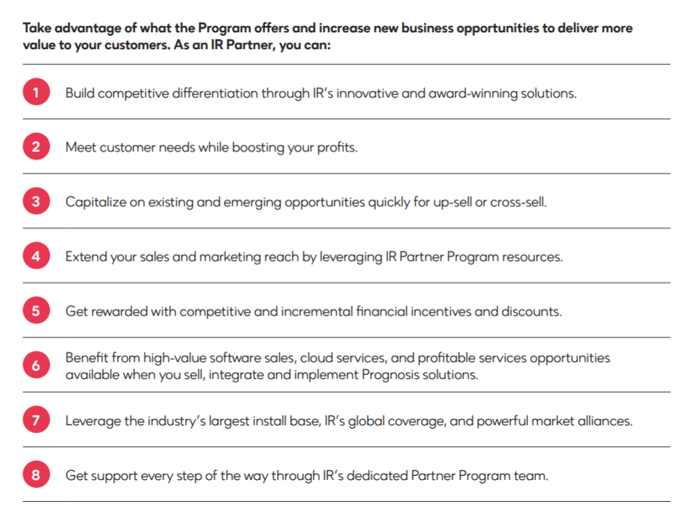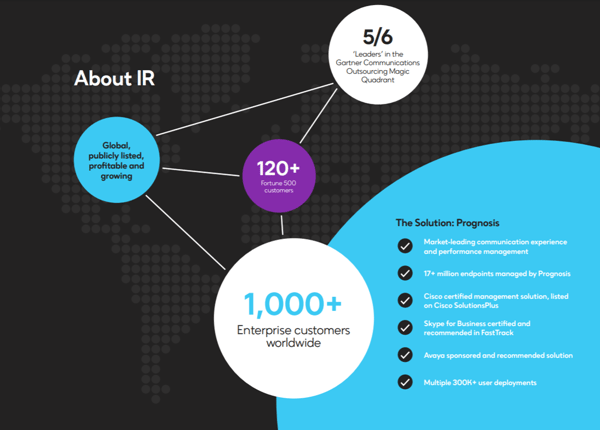How service providers can own UC optimization
It’s important for your team to have a positive and rewarding experience. As a UC service provider (SP), it’s your job to make sure your customers have a great experience, every time. Your customers come to you because they don’t want to deal with service issues – they want you to handle it.
Table of Contents
How IR can help service providers
Accelerate time revenue
SPs can reduce their time to deploy and activate new managed customers faster with Prognosis. Prognosis gives SPs new innovative revenue streams that provide value-added services for customers. Flexible deployment and operation models support many SP business models including private cloud hosting, premise remote managed, single and multi-tenant, etc. Prognosis enables streamlined deployment with a minimal technology footprint through virtualized software and API-based data gathering. No need for hardware probes.
Reduce service delivery costs and improve efficiency
Being forced to employ separate tools for various vendor systems to gain visibility and insight is costly and inefficient. Prognosis for Service Providers reduces costs and improves service delivery efficiency across multi-vendor UC and CC services. It minimizes downtime and improves mean-time-to-repair (MTTR) for service impacting incidents with costly SLA penalties and customer dissatisfaction. Prognosis offers a centralized view across customers in one operator experience; from single solution to multitenant deployment architecture.
- Automatic integration with incident management and other critical IT.
- Operations systems streamlines deployment and simplifies management.
- Comprehensive alerting and customized thresholds.
Meet SLAs and deliver customer satisfaction
The monetary penalties dealt from not meeting SLAs hurts revenue and margin. Deliver peace of mind to customers with proactive UC monitoring, alerting and troubleshooting. Prognosis provides deep domain experience with service provider expertise built in, plus customer access to view performance reports and validate service delivery.
Unlock the power of the IR Partner Program

The best practices offered in this guide can help UC teams manage their UC environments effectively. The IR Partner Program offers benefits as well, providing many ways to differentiate our partners’ businesses from their competition.
The program offers multi-vendor UC, CC and network assessment solutions, training, tools, rewards and support to enable our Partners to drive toward profitable growth and customer satisfaction.

Recognizing Partner commitment
IR formally recognizes Partners who have invested time and resources in developing significant expertise in Prognosis products and solutions.
Partner enablement
Our members can build their competencies and skills through a variety of educational, community, training and knowledge-based opportunities that include:
- Access to a free online training tool with role-based, guided learning paths to facilitate individuals becoming. Prognosis specialists across a variety of functions including sales, presales, support and implementation.
- Local, partner-exclusive support.
Partner quickfire with Kathleen Ryan, ConvergeOne
- Why did you join the IR Partner Program?
The benefits seemed to be greater than ConvergeOne’s program from a rebate perspective and because our partnership is important to us. - What are the biggest benefits of the program?
The financial benefits, rebates and market development funds, as well as the designated Channel Manager - Would you recommend other businesses join the program?
Yes, the focus IR has on Partners in the program really strengthens the relationship.
Looking ahead: UC trend watch
We’ve gathered IR team insights, industry research, and expert opinion to help prepare you for what lies ahead in unified communications. Here’s what we’ve uncovered.
Digital transformation will reach the moment of truth
After years of investing in digital transformation initiatives, companies will finally have to demonstrate a concrete ROI in 2018. Organizations that have rushed ahead with projects that are not delivering ROI, or worse, are resulting in a poor customer experience, will gain public notoriety and suffer damage to their brand.
Adoption of UC as a Service (UCaaS) will accelerate, but most enterprises will opt for a hybrid model
Organizations have discovered that moving to the cloud does not have to be an all-or-nothing proposition. Over the next several years, the hybrid approach will remain popular, transitioning some systems to the cloud while continuing to run others on their on-premises infrastructure. Hybrid UC solutions take advantage of the on-premises infrastructure companies have already invested in and allow them to successfully marry that infrastructure with cloud services.
Early adopters will discover UCaaS can add cost and complexity
Despite the promise of improved service, moving to the cloud can mean adding even more vendors – and layering on another level of complexity and cost. Companies will gain flexibility from UCaaS, but it’s not a silver bullet; there will be challenges. For example, employees working from home will want to use their preferred devices and expect a similar experience to what they have in the office. So, what happens if they have a bad user experience?
UC teams will be expected to troubleshoot and resolve, fast. In this multi-vendor environment, it becomes increasingly hard. The truth is that you need the proper expertise to support a cloud deployment, just like an on-premises environment. Smart organizations will budget for increased costs and manage complexity by ensuring that they have vendor-independent UC management tools, which provide visibility across the entire hybrid UC ecosystem to quickly find the root cause of issues.
Voice and video communications will increasingly be one-to-many, rather than one-to-one
Research shows that conference calls now represent up to 40% of all voice traffic in the enterprise. This means employees are increasingly communicating through group collaboration solutions. The trend will gain even more momentum in 2018, especially as the enterprise continues its rapid adoption of team messaging and collaboration solutions such as Microsoft Teams, Cisco Spark and Slack.
Companies will embrace browser-based and in-app communications
Businesses can enhance customer interactions and increase productivity in 2018 by embedding realtime multimedia communications capabilities directly into a web browser or mobile application. Take, for example, a commercial bank. Many banks are mainly communicating with their customers solely through their app. Think about it: when was the last time you needed to go into your local bank branch? Most customer interactions take place online, via a web browser or mobile app.
Artificial intelligence will greatly improve the customer experience
Consumers are increasingly connecting with AI assistants like Siri, Cortana and Alexa in their daily lives. It’s only a matter of time before these kinds of bots will be accepted in a business environment. AI is already dramatically changing call centers, making them more efficient with bots that can quickly answer the questions most commonly asked by customers. AI is even helping to predict customer behavior, providing advice to customer service reps on how best to solve an issue. In 2018, we will see even greater acceptance of bots as a legitimate alternative to human interaction for customer service.
Managed service providers will be more important than ever
MSPs are uniquely positioned to give support and advice to companies that are driving toward digital transformation. Most organizations today are not on a single UC platform. They’re on disparate platforms from a number of different vendors. To succeed, they need to seamlessly monitor, manage and optimize this multi-vendor environment. MSPs know how to integrate all the moving parts – the hardware, software, network components, gateways, phones, headsets – to get the most out of these systems. Should organizations want a customized cloud service, MSPs can offer more flexibility than a vendor.
2018 predictions

Q: We saw Cisco announce their intention to acquire BroadSoft in October – what impact will this have in 2018?
A: I think this is a very positive move for Cisco, which was struggling in the mid-to-low end of the cloud market. BroadSoft gives Cisco a strong solution for service providers to sell cloud solutions, and I expect them to do well with it. It will cause some competition for companies that compete with BroadSoft, such as GENBAND and Metaswitch, and will also create more competition for companies like RingCentral and Five9.
Some of BroadSoft’s partners are concerned about how they’ll fit in a Cisco world, especially the Tier 2 and 3 players. I believe the Tier 1 players like Verizon and AT&T really welcome this news, but the smaller players are more concerned. They’re afraid that they won’t get the love and attention from Cisco that they got from BroadSoft.
Q: Do you think the Skype for Business Online/Microsoft Teams announcement at Ignite rocked the boat for Skype for Business? How do you see this playing out in 2018?
A: I think this actually sets Microsoft back a bit – customers will put decisions on hold until they hear more from Microsoft about dates and service offerings. Right now, it looks like they muddied the water a bit. Teams doesn’t have telephony features, and Microsoft has stated they will be available in the second half of 2018 via integration to the Skype for Business Enterprise Server. The lack of clarity right now will cause some customers to look for alternatives for telephony.
Q: Do you think Avaya is likely to make any big waves on the UC market in 2018 after their emergence from Chapter 11?
A: Under new leadership, I expect to see Avaya moving quickly to show that they haven’t been keeping still while going through Chapter 11. Avaya’s big push in 2018 will be in the cloud. I don’t know if they’ll be making any big waves, but they’ll need to show that they’re still innovative and not just supporting an aging product base. A big part of what Avaya will be doing in 2018 will be focusing on verticals. The company has also been busy innovating and will be introducing products related to AI, bot frameworks, blockchain, and other emerging areas.
Q: What UC trends do you think will dominate 2018?
A: AI will be a big trend as companies add AI capabilities to their offerings. This will range from basic bots (which may or may not be considered AI), to intelligent assistants that help schedule and manage meetings and calendars.
2018 predictions

Q: What impact do you believe the Skype for Business Online/Microsoft Teams announcement at Ignite had on the market? How do you see this playing out in 2018?
A: In the short-term, I think the Microsoft Teams announcement caused some consternation in the UC market, including confusion among customers and non-customers about how to proceed (Skype for Business versus Teams). IDC has heard from some customers that Microsoft has been aggressively trying to move them to Office 365, but investment protection, and/or the overall metrics and drivers for such a move may not be there yet for them, causing some friction.
Within enterprises, even though several departments are mostly consolidated under IT now, telecom personnel have traditionally shown themselves to be somewhat conservative and very deliberate in moving to new communications technology – a buying behavior we think Microsoft must more effectively address as it continues to execute on its Office 365 and Teams vision and go-to-market strategy moving forward. Longer term, I believe there is growing support for team collaborative/chat-based applications and Microsoft will continue to offer good enhancements and options to the Teams capabilities to appease its customers.
Q: From your perspective, what role does UC play in digital transformation?
A: I believe UC will play a critical role in digital transformation and feel that this fact is still not completely understood by many enterprises. In general, I think many organizations tend to underestimate the role that communications will play in many digital transformation initiatives.
Q: What UC&C trends do you predict will emerge in 2018?
A: We expect to see more interest in team collaborative applications, “intelligent” communications with more integrated cognitive capabilities, AI and ML integrated capabilities, and voice-activated digital assistants for easier, more intuitive to access to calendars and applications. We also think more organizations will begin to consider infrastructure technology such as SDWAN in support of their UC deployments.
Q: What advice would you give to organizations that are currently evaluating their options for migrating UC&C to the cloud?
A: Recent end-user adoption data from IDC’s U.S. Enterprise Communications Survey, 2017: Unified communications & Collaboration (May 2017) highlights that a healthy percentage (54%) of respondent organizations prefer a hybrid approach to deploying new UC&C solutions (i.e., a mix of cloud and premises). So, if you are a bit apprehensive about moving to the cloud, consider moving one or two communications components or applications (e.g., messaging or conferencing) as a first step toward cloud, then build from there.
Conclusion
Delivering a great user experience across your UC environment is no small task. But with careful planning, an energized and productive team, and the right technology partners, you can optimize UC management in a way that enhances the communications experience for your colleagues and customers alike.

Unified Communications helps enhance communication within your company to better support collaboration and productivity. To read more about UC and how it can work for your business, read the rest of this series:


